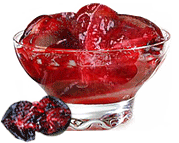 Full List of Fruits
Full List of Fruits  Ceylon Gooseberry
Ceylon Gooseberry
Ceylon Gooseberry
Ethnic names :Ketembilla (America)
Scientific Name :Dovyalis hebecarpra
Origin : It is believed to be a native of Srilanka and India. The fruit is also cultivated in South Africa.
Appearance : Its tree is small shrubby and spiny which is about 6m tall. The fruit is orange initially but turns to dark purple color when it ripens. It is 2-3 cm in diameter and is surrounded with short, grayish green, velvety hairs. Pulp of the fruit is purple-red in color. The seeds are long and hairy.
Ceylon gooseberry fruit is a good source of vitamins and minerals. Slightly unripe fruits have high pectin content. Here is a nutritional chart which gives information about the nutrient content in Ceylon gooseberry fruit.
| Vitamins (Per 100 g) | |
| Vitamin B1 (thiamine) |
0.017 mg |
| Vitamin B2 (Riboflavin) |
0.030 mg - 0.044 mg |
| Vitamin B2 (Niacin) |
0.261 mg - 0.316 mg |
| Vitamin C (Ascorbic Acid) |
91.8 mg -102.4 mg |
| Carotene | 0.123 mg - 0.358 mg |
| Minerals ( Per 100 g) | |
| Moisture | 82 g - 83.5 g |
| Protein | 0.176 g- 0.204 g |
| Calcium | 12.6 mg- 13.8 mg |
| Iron | 0.93 mg-1.44 mg |
| Fat | 0.64 g - 1.02 g |
| Crude Fiber | 1.6 g - 2 g |
| Ash | 0.63 g - 0.65 g |
| Phosphorus | 24.4 mg - 26.9 mg |
- The tree takes about 2-3 years to fruit and fruiting occurs from spring to early summer.
- It is cultivated in warm countries as hedge plants.
- It is distributed by seeds and cuttings.
- Ceylon gooseberry is often used as a barrier hedge due to the thorns on it and its vigorous growth habit.
- Cultivated hybrids of the fruit are also available.
- It is good when mixed in drinks and nowadays it is occasionally cultivated for juice making.
- Since the pulp of the fruit is very juicy, it is either used as a flavoring for beverages or for preserves.
- In most of the countries, it is used for juice, spiced jelly, ketimbilla-guava jelly, ketembilla-apple butter and ketimbilla-papaya jam.
- The fruit has a high content of vitamin C which is necessary for healing wounds and for repairing and maintaining bones and teeth.
The pulp of the fruit is very juice and extremely acidic. It contains several small seeds. The fruit is often eaten raw or made into jam and tastes similar to gooseberry. Ceylon gooseberry is cultivated in many parts of the world on a small scale.
The plant grows rapidly under ideal conditions. Though it requires a lot of moisture for proper fruit development, the plant tolerates dry and wet soils. The propagation of the fruit is carried out by fruits. In Florida, the plant bears multiple crops throughout the year and the fruits are borne in great abundance. In Israel, the fruit ripens from winter to spring.
 Ceylon Gooseberry Recipes
Ceylon Gooseberry Recipes
Ingredients:
- 3 pounds fully ripe Ketembilla
- 2 - 3 cups of water
- 1 pouch liquid pectin
- 2 tbsp cup lime juice
- Sugar as required

Method:
- Wash the fruits and place them in a bowl with water.
- Boil it in simmer for around 10 minutes.
- Cool it and strain through jelly bag.
- Then make 3 ¾ cups juice and boil again in large bowl.
- Add lime juice and some sugar to it.
- Then add pectin and boil for 1 minute by stirring it continuously.
- Pour into jars and seal.
- Yummy jelly is ready.

Ingredients:
- 16 ketembilla seedless fruits
- 2 large bananas
- Honey as required
- 1 envelope of plain gelatin (flavoring agent)
- Whipped cream or topping
Method:
- Mix together ketembilla, bananas and honey.
- Dissolve gelatin in it.
- Pour this mixture into mold and refrigerate until it is set.
- Then serve with whipped creaming or topping.
















